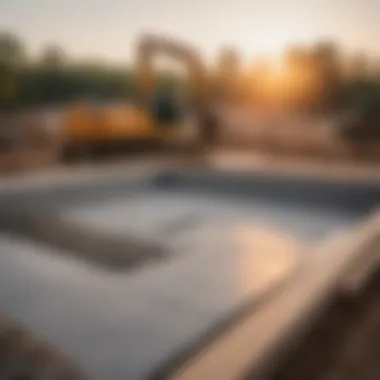Materials:
- Concrete mix: 20 bags of high-quality concrete mix ensuring a strong foundation.
- Gravel: 4 cubic yards of gravel for proper drainage and stability.
- Wooden stakes: 10 stakes to mark the perimeter of the pad accurately.
- String: Sufficient string to outline the pad's dimensions for precision.
- Rebar: 15 pieces of rebar to reinforce the concrete and prevent cracks.
DIY Steps:
- Planning: Measure and mark the area for the concrete pad ensuring it is level and square.
- Excavation: Dig the designated area to a depth of 4 inches, removing any rocks or debris.
- Gravel Base: Pour and level gravel at a 2-inch depth, compacting it for proper drainage.
- Rebar Installation: Place rebar in a grid pattern for reinforcement within the pad.
- Mixing Concrete: Follow instructions on the concrete mix bags and prepare the mixture accordingly.
- Pouring Concrete: Pour the concrete evenly onto the pad area, spreading it with a screed board.
- Smoothing Surface: Use a bull float to level and smooth the surface of the concrete.
- Finishing Touches: Add a broom finish or any desired texture before allowing the concrete to cure.
Technical Aspects:
- Tools: Wheelbarrow, shovel, hoe, level, trowel, bull float, screed board, and broom.
- Timing: Plan for a day to complete excavation, framing, and concrete pouring and allow time for curing.
- Critical Techniques: Proper concrete mixing consistency, accurate rebar placement, and precise leveling are vital.
DIY Project Process:


- Ensure precise measurements and leveling at every stage to guarantee a stable and durable concrete pad.
- Watch for air bubbles while pouring concrete and use a vibrating tool to eliminate them for a stronger finish.
For Troubleshooting Tips, if cracks appear during curing, apply a sealant to prevent further damage and ensure longevity of the concrete pad.
Preparation Phase


The Preparation Phase is a critical aspect of constructing a level concrete pad as it sets the foundation for the entire project. This phase encompasses several key elements that are essential for ensuring a sturdy and durable outcome. By meticulously planning and executing this phase, you can significantly improve the overall quality and longevity of your concrete pad.
Site Selection
Choosing the Right Location
Choosing the right location for your concrete pad is paramount in achieving a successful construction project. The location you select will impact factors such as stability, accessibility, and future use of the pad. It is crucial to choose a flat, level area that is free from obstructions such as tree roots or underground pipes. Additionally, selecting a spot with good drainage will help prevent water buildup that could compromise the integrity of the concrete over time.
Considerations for Drainage and Orientation
Considering drainage and orientation during the site selection process is vital for the long-term performance of your concrete pad. Proper drainage ensures that water does not pool on the surface, preventing potential damage from water infiltration. Orienting the pad in a way that maximizes sunlight exposure can also promote faster drying and reduce the risk of moisture-related issues.
Excavation
Determining Depth Requirements
Determining the appropriate depth for excavation is a crucial step in preparing the site for the concrete pad. The depth requirements will vary depending on factors such as soil type, intended use of the pad, and local building codes. Ensuring the correct depth is essential for providing adequate support and stability for the concrete structure.
Clearing the Site of Debris
Clearing the site of debris is necessary to create a clean and safe working environment for the construction process. Removing rocks, roots, and other debris from the site prevents uneven settling of the concrete and helps maintain a smooth surface. It also reduces the risk of damage to the equipment used during excavation.
Formwork Setup
Materials Needed
Selecting the appropriate materials for formwork setup is crucial for ensuring the structural integrity of the concrete pad. Common materials include lumber, plywood, and steel reinforcements. Choosing high-quality materials that can withstand the pressure of the concrete being poured is essential for a successful construction project.
Setting Up Formwork Properly
Properly setting up the formwork is essential for achieving the desired shape and dimensions of the concrete pad. Careful attention to detail during the setup process will help prevent leaks, bulges, or uneven surfaces in the finished product. Ensuring that the formwork is secure and level is key to a successful concrete pour.
This comprehensive guide to building a level concrete pad emphasizes the importance of the Preparation Phase in laying the groundwork for a sturdy and durable foundation. By following the detailed instructions outlined in this guide, you can navigate each step with confidence and precision, ultimately resulting in a high-quality concrete pad that meets your project requirements.
Foundation Preparation


Foundation preparation is a critical phase in the process of building a level concrete pad. Ensuring a solid and stable foundation is essential for the longevity and durability of the structure. In this stage, attention to detail is key to avoid any future issues related to settling or cracking of the concrete pad. By focusing on proper compaction, subbase installation, and rebar placement, you are laying the groundwork for a successful and reliable concrete pad that will stand the test of time.
Compaction
Soil Compaction Techniques
Soil compaction techniques play a pivotal role in ensuring the stability and strength of the concrete pad. By compacting the soil effectively, you are reducing the air gaps within the soil, which helps in preventing any future settling or unevenness. One of the key characteristics of soil compaction techniques is their ability to increase the soil's density, providing a firm base for the concrete slab. This method is widely favored in construction due to its proven track record of enhancing the performance and longevity of concrete structures. The unique feature of soil compaction lies in its ability to create a sturdy and uniform base that supports the weight of the concrete without any shifting or sinking. While advantageous in providing a solid foundation, soil compaction techniques require meticulous attention to detail to ensure optimal results.
Ensuring Uniformity
Ensuring uniformity in the compaction process is crucial for laying the groundwork for a level concrete pad. Uniform compaction minimizes the risk of uneven settling or cracks in the concrete over time. The key characteristic of ensuring uniformity is the consistent application of compaction techniques throughout the entire site, maintaining a standard level of soil density. This approach is highly beneficial for creating a structurally sound foundation that can withstand various external factors. The unique feature of ensuring uniformity lies in its ability to distribute the load-bearing evenly, contributing to the overall stability and integrity of the concrete pad. While advantageous in promoting structural uniformity, ensuring uniformity requires precise execution to achieve the desired level of stability and durability.
Subbase Installation
Layering Process
The layering process in subbase installation plays a vital role in supporting the concrete pad. By creating distinct layers of different materials with varying compaction levels, you are establishing a strong and robust base for the concrete. The key characteristic of the layering process is its ability to enhance load-bearing capacity and drainage efficiency, promoting the overall health of the concrete structure. This method is popular among construction experts for its effectiveness in increasing the longevity and durability of concrete pads. The unique feature of the layering process lies in its versatility to accommodate different soil types and site conditions, adapting to various construction needs. While advantageous in providing a resilient foundation, the layering process requires meticulous planning and execution to achieve the desired structural integrity.
Compacting the Subbase
Compacting the subbase is a critical step in ensuring a solid foundation for the concrete pad. Proper compaction of the subbase material reduces the risk of settlement and enhances the load-bearing capacity of the base. The key characteristic of compacting the subbase is its ability to compress the material into a dense and stable layer, crucial for supporting the weight of the concrete slab. This method is a popular choice in construction due to its proven effectiveness in minimizing future structural issues. The unique feature of compacting the subbase lies in its capacity to prevent soil erosion and maintain the integrity of the base over time. While advantageous in providing a sturdy foundation, compacting the subbase demands precision and thoroughness to ensure long-lasting structural support.
Concrete Pouring
Concrete pouring is a critical stage in the construction of a level concrete pad. This section delves into the pivotal aspects of mixing the concrete, pouring it onto the prepared surface, and ensuring that the foundation is robust and secure. The quality of the concrete mix and the method of pouring directly impact the strength and durability of the structure.
Mixing
Correct Ratio of Ingredients
Achieving the correct ratio of ingredients in the concrete mix is paramount to the success of the pouring stage. The precise combination of cement, aggregates, and water plays a significant role in determining the strength and integrity of the concrete pad. The ideal proportions ensure that the concrete achieves the desired consistency for optimal results, guaranteeing a solid foundation that can withstand the test of time.
Consistency for Optimal Results
Maintaining consistency in the concrete mix is crucial for achieving optimal results during the pouring stage. The right consistency allows for uniform distribution of the concrete, preventing weak spots or segregation in the mixture. A uniform mix ensures that the concrete pad sets evenly, minimizing the risk of cracking or areas of weakness. Consistency in the mix is a key factor in producing a high-quality and durable concrete foundation.
Pouring Techniques
Strategies for Uniform Distribution
Employing effective strategies for uniform distribution of the concrete during pouring is essential for creating a level and stable foundation. Proper techniques such as using a screed board or vibrating the concrete help in achieving an even distribution of the mix across the entire pad. Uniform distribution eliminates inconsistencies in the surface, promoting structural integrity and ensuring the longevity of the concrete pad.
Avoiding Air Pockets
Preventing the formation of air pockets within the poured concrete is imperative to the structural strength of the pad. Air pockets can weaken the concrete and lead to cracking or spalling over time. Techniques such as compacting the concrete mix properly and using proper pouring methods help in reducing the presence of air pockets, enhancing the overall quality and durability of the foundation.
Finishing Touches
Smoothing the Surface
Smoothing the surface of the concrete pad is a crucial final step that enhances both the appearance and functionality of the structure. Achieving a level and smooth finish not only provides visual appeal but also ensures that the surface is even and free of imperfections. A properly smoothed surface reduces tripping hazards and makes maintenance easier, contributing to the longevity of the concrete pad.
Curing Methods
Implementing appropriate curing methods is essential for allowing the concrete to achieve its full strength and durability. Adequate curing involves techniques such as covering the concrete with curing compound or moist curing to prevent rapid moisture loss and ensure proper hydration of the cement. Proper curing enhances the resistance of the concrete pad to cracking and improves its long-term durability and structural integrity.
Curing and Maintenance
In the process of building a level concrete pad, the stage of curing and maintenance plays a pivotal role in ensuring the longevity and durability of the structure. Curing involves maintaining adequate moisture for an optimal amount of time to allow the concrete to achieve its maximum strength and durability. This critical phase should not be overlooked, as it directly influences the quality of the final product. Maintenance, on the other hand, encompasses the measures taken post-construction to prevent issues such as cracks and ensure the long-term integrity of the concrete pad.
Curing Process
Duration for optimal strength
When it comes to curing concrete for a level pad, the duration for optimal strength is a crucial factor. This aspect refers to the period during which the concrete needs to be kept moist to achieve its highest strength potential. Typically, a curing period of around 7 to 14 days is recommended for most concrete mixes to develop the desired strength and durability. This extended moisture exposure allows the chemical processes within the concrete to complete efficiently, resulting in a robust and long-lasting pad. The unique feature of this extended curing time is that it significantly enhances the concrete's resistance to cracking and increases its overall structural integrity. While it may require some patience, investing in the adequate duration for curing ultimately leads to a more resilient concrete pad.
Protective measures during curing
Protective measures during the curing process are essential to safeguard the freshly poured concrete from external factors that could compromise its strength and quality. These measures include covering the concrete with plastic sheets or wet burlap to retain moisture, especially in hot and dry conditions where rapid moisture loss can occur. Additionally, it is important to ensure that the curing environment is free from excessive temperature fluctuations and protected from direct sunlight, which can cause premature drying and cracking. Implementing these protective measures during curing not only enhances the concrete's overall strength but also reduces the risk of surface imperfections and structural weaknesses.
Maintenance Tips
Preventing cracks
One of the key aspects of maintaining a level concrete pad is preventing cracks, which can significantly impact its stability and aesthetics. To mitigate the risk of cracks, it is essential to control the drying process by regularly moistening the surface and applying a curing compound to seal the concrete and retain moisture. Proper jointing techniques, such as saw cuts at strategic locations, can also help relieve internal stresses and prevent random cracking. By focusing on preventing cracks through diligent moisture control and strategic jointing, you can ensure that your concrete pad remains structurally sound and visually appealing.
Long-term care
Long-term care for a concrete pad involves proactive measures to extend its lifespan and durability. This includes regular inspections for signs of wear and aging, such as surface spalling or discoloration, and addressing any issues promptly to prevent further deterioration. Applying a sealer every few years can help protect the concrete from moisture penetration, chemical exposure, and abrasion, prolonging its aesthetic appeal and structural integrity. By prioritizing long-term care through consistent maintenance routines and timely repairs, you can enhance the longevity of your concrete pad and preserve its functionality for years to come.





